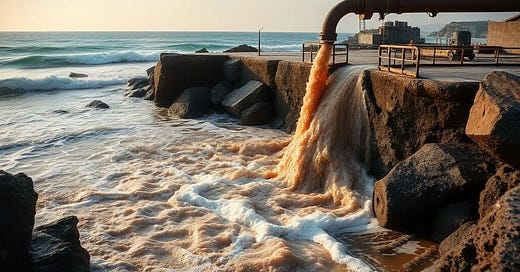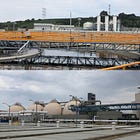The Tijuana River Valley Sewage Crisis: Understanding the Problem and Solutions
The residents of San Diego's County communities have been battling an invisible yet unmistakable enemy: the rotten egg smell of hydrogen sulfide (H₂S) gas wafting from the Tijuana River Valley. What many visitors might mistake for a temporary inconvenience has become a persistent public health concern with deep roots in international infrastructure challenges. Let's break down this complex issue to understand what's happening, why it matters, and what's being done to address it.
What's Happening: The H₂S Problem
The Tijuana River Valley, situated along the U.S.-Mexico border, has become ground zero for an environmental crisis involving hydrogen sulfide emissions. This colorless gas with its characteristic rotten egg smell isn't just unpleasant—it's a direct result of raw sewage decomposition.
Since October 2023, over 31 billion gallons of untreated sewage, polluted stormwater, and trash have flowed from Tijuana into the Tijuana River Valley and ultimately the Pacific Ocean. The raw sewage breaks down in the environment, releasing H₂S gas that permeates the air in surrounding communities.
Impact on the Community
The impacts of this crisis extend far beyond unpleasant odors:
Health Concerns: Residents report headaches, nausea, and respiratory issues from prolonged exposure to the gas. According to a 2024 San Diego State University report, the contamination has created a full-blown public health crisis with toxic chemicals and microbes found in both air and soil.
Closed Beaches: The sewage flows have led to extended beach closures along the Southern California coast, impacting tourism and recreational activities.
Quality of Life: Local schools sometimes keep children indoors during recess due to air quality concerns, while residents find themselves unable to enjoy outdoor activities or even open their windows on particularly bad days.
Environmental Damage: The ecological impact on the Tijuana River Valley's sensitive habitats has been severe, with wildlife and plant communities suffering from continued pollution.
Economic Toll: Property values, local businesses, and tourism all suffer when an area becomes known for persistent environmental problems.
The San Diego Air Pollution Control District (SDAPCD) has received hundreds of odor complaints, particularly during mid-July 2024, highlighting the extent of community impact.
Root Cause: A Cross-Border Infrastructure Challenge
At its core, this crisis stems from several interconnected infrastructure failures:
Insufficient Treatment Capacity: Tijuana's rapid growth has outpaced its wastewater infrastructure development. The city simply cannot process all the sewage its population produces.
Infrastructure Breakdowns: Pump failures, operational issues, and maintenance problems plague the existing systems on both sides of the border. For example, a failure at the Hollister Street Pump Station in June 2024 led to millions of gallons of untreated sewage flowing through canyon collectors.
Transboundary Flows: During both dry weather and rainstorms, untreated sewage from Tijuana flows northward through the Tijuana River and several canyon systems, overwhelming U.S. collection and treatment systems.
Weather Factors: Heavy rains exacerbate the problem by overwhelming the already strained infrastructure, while heat waves intensify odors as decomposition accelerates.
Maintenance Challenges: Recent incidents highlight ongoing issues, such as Mexico's reported plan to dump 400 million gallons of sewage into the Tijuana River due to maintenance requirements.
The South Bay International Wastewater Treatment Plant (SBIWTP), operated by the U.S. International Boundary and Water Commission (USIBWC) near the border, was designed to treat some of these flows but has been overwhelmed by the volume and frequency of sewage releases.
The Role of Government Agencies
Multiple agencies are involved in addressing different aspects of this crisis:
San Diego Air Pollution Control District (SDAPCD)
Monitors air quality with expanded sensor networks to track H₂S and other pollutants
Investigates odor complaints from residents
Issues violations to responsible parties like USIBWC and its contractor Veolia
Communicates with affected school districts about air quality issues
While essential for managing symptoms (odors), SDAPCD's role is limited to air quality regulation and doesn't extend to fixing the sewage problem itself
U.S. International Boundary and Water Commission (USIBWC)
Operates the South Bay International Wastewater Treatment Plant
Manages five canyon collectors designed to capture dry weather transboundary flows
Works with Mexican counterparts to implement joint solutions
Has faced criticism and violations for operational failures
Environmental Protection Agency (EPA)
Implements solutions under the United States-Mexico-Canada Agreement (USMCA)
Provides funding for infrastructure improvements
Coordinates near-term projects such as diversion systems and trash collection
Partners with local agencies like the City of San Diego on specific projects
San Diego Regional Water Quality Control Board
Monitors and reports on sewage pollution in the watershed
Documents spill events and transboundary flows
Enforces water quality regulations
State of California
Has allocated $35 million since 2019 for cleanup efforts
Provided $2.7 million for air purifiers for affected residents
Funds the Tijuana River Valley Recovery Team
Governor Newsom has advocated for federal support
Mexico's National Water Commission (CONAGUA)
Responsible for wastewater infrastructure in Tijuana
Partners with U.S. agencies on joint solutions
Faces significant funding and capacity challenges
This complex web of agencies highlights the challenge of addressing a transboundary issue where responsibilities are divided across international boundaries and multiple levels of government.
Solutions to Fix the Root Cause
Addressing the sewage crisis requires substantial infrastructure investments and international cooperation. Several key solutions are underway:
1. Expanding Treatment Capacity in the U.S.
The U.S. and Mexico agreed in 2022 to invest $474 million to address the sewage crisis, with a significant portion dedicated to doubling the capacity of the South Bay International Wastewater Treatment Plant. This expansion aims to increase treatment capacity by 43 million gallons per day, substantially reducing untreated sewage flows.
The federal government has committed to rehabilitating and expanding the SBIWTP, with $350 million appropriated and an additional $103 million allocated in 2024. These upgrades represent the most significant improvement to the treatment infrastructure in decades.
2. New Treatment Plant in Mexico
A new wastewater treatment plant is under construction in Mexico at San Antonio de los Buenos, with a daily capacity of 5 million gallons. This plant will eliminate sewage reaching the San Antonio de los Buenos Creek, which discharges into the Pacific Ocean, reducing transboundary pollution.
3. Infrastructure Improvements
Additional infrastructure upgrades include:
A diversion system to increase treatment at the IBWC International Treatment Plant by 10 million gallons per day
Trash booms added to the river's main channel to prevent debris from flowing downstream
Sediment control projects in areas like Smuggler's Gulch
Upgrades to the five canyon collectors (Stewart's Drain, Canyon del Sol, Silva Drain, Smuggler's Gulch, Goat Canyon) that capture dry weather flows
4. International Cooperation
The issue is governed by the 1944 Water Treaty and subsequent agreements, which assign primary responsibility to Mexico for preventing wastewater discharge while the U.S. provides assistance. Recent efforts under the USMCA have directed the EPA to implement technical solutions with international cooperation.
Progress and Challenges
While these solutions offer hope, significant challenges remain:
Timeline for Implementation: Many of the major infrastructure projects are still in development, with completion dates extending several years into the future.
Ongoing Maintenance Issues: Recent spills highlight the continued vulnerability of the system to operational failures.
Funding Gaps: Despite substantial investments, the scale of the problem may require additional resources.
Climate Change: Extreme weather events may further stress the infrastructure as climate patterns shift.
What's Next?
The path forward requires sustained attention and resources:
Continued Monitoring: SDAPCD's expanded air quality monitoring will provide crucial data about H₂S levels and trends.
Community Advocacy: Keeping public pressure on agencies to implement solutions remains important.
Project Completion: Ensuring the timely completion of the SBIWTP expansion and the new treatment plant in Mexico is critical.
Preventive Maintenance: Developing better maintenance protocols to prevent system failures before they occur.
Long-term Planning: Considering climate resilience and population growth in future infrastructure planning.
Conclusion
The Tijuana River Valley sewage crisis represents a complex environmental challenge that crosses international boundaries and requires multi-agency coordination. While the air quality impacts monitored by SDAPCD are significant, addressing the root cause—raw sewage flows—requires substantial infrastructure investments both in the U.S. and Mexico.
The good news is that meaningful solutions are underway, with unprecedented funding committed to expand treatment capacity and improve collection systems. However, residents will likely continue experiencing impacts until these projects are completed. In the meantime, agencies like SDAPCD play a crucial role in monitoring conditions and holding responsible parties accountable for violations.
This crisis reminds us that environmental issues don't respect political boundaries, and solving them requires international cooperation, substantial investment, and the collective will to protect public health and natural resources.
Be sure to read my previous blog on H2S problems!
References
SDAPCD air quality monitoring for H2S levels in Tijuana River Valley
San Diego Regional Water Quality Control Board on Tijuana River sewage pollution
Fox News report on sensors for pungent odor near Tijuana River Valley
SDAPCD investigations into odor complaints in Tijuana River Valley
Yahoo News on sensors for monitoring Tijuana River Valley odor
San Diego Coastkeeper overview of Tijuana River sewage crisis causes and consequences
EPA news release on U.S. and Mexico investing $474M for Tijuana River sewage
Governor of California on federal commitment to fix Tijuana River sewage crisis
EPA news release on two near-term clean water projects for Tijuana River
Engineering News-Record on EPA plans for $627M in Tijuana River sewage projects
Fox News on Mexico dumping sewage into Tijuana River affecting U.S.
Governor of California on Newsom's visit to Tijuana River rehabilitation efforts
SDSU news on public health crisis from Tijuana River sewage contamination
ASCE article on wastewater improvements targeting Tijuana River pollution
EPA on USMCA directives for Tijuana River watershed solutions
Legal Disclaimer: This blog is not related to my employer and reflects only my professional opinions. The content provided on this blog is for informational purposes only and represents my personal opinions. It is not intended to be legal advice and should not be relied upon as such. For specific legal advice, please consult with a qualified legal professional.





